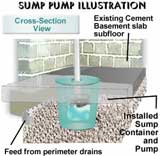If you have already lived through the dreaded experience of a flooded basement, then you know how much damage it can cause. Even one inch of water can take many hours to clean up and causes thousands of dollars in damaged furniture and carpets. Installing a sump pump in your basement is your best defense to prevent flooding.
Checking your sump pump
It is important to check your sump pump regularly to make sure that it is in proper working condition. Check these suggestions for more details:
- Remove the cover and slowly pour water into the sump tank.
- Watch for the “float” to rise and trigger the pump.
- Once the pump is engaged, the water level will quickly lower and the float will shut off the pump.
- This is what is called “a normal sump cycle”.
If you notice anything out of order, you should call Heritage today before it’s too late. Our technicians are available 24/7 to prevent you from the damage and misery of a flooded basement.
Why do I need a sump pump?
 A sump pump is used in the basement to prevent the buildup of water around the concrete foundation. If water collects around or under a basement foundation, the water pressure can cause the concrete to crack resulting in possible leaks. To prevent the water pressure, perforated drain tile is placed around the basement foundation and along the basement walls allowing water to seep into the tile and gravity feed to the sump pit. The sump pit will have a pump installed that discharges the water into a sanitary main or storm water pipe. Some sump pits will be perforated with rock around the pit to catch the water that builds up under the foundation. Either application rather drain tile pipe or a sump pit with perforation, both will have small rock surrounding them to filter the water entering the pit from mud or particles. Most sump pits will be between 15″ to 18″ in diameter and have a depth of around 24″. Anything smaller could cause the pump to run too often or not handle the volume of demand.
A sump pump is used in the basement to prevent the buildup of water around the concrete foundation. If water collects around or under a basement foundation, the water pressure can cause the concrete to crack resulting in possible leaks. To prevent the water pressure, perforated drain tile is placed around the basement foundation and along the basement walls allowing water to seep into the tile and gravity feed to the sump pit. The sump pit will have a pump installed that discharges the water into a sanitary main or storm water pipe. Some sump pits will be perforated with rock around the pit to catch the water that builds up under the foundation. Either application rather drain tile pipe or a sump pit with perforation, both will have small rock surrounding them to filter the water entering the pit from mud or particles. Most sump pits will be between 15″ to 18″ in diameter and have a depth of around 24″. Anything smaller could cause the pump to run too often or not handle the volume of demand. 
There are two types of pumps: Pedestal and Submersible.
A Pedestal pump has a motor outside the sump pit, and a shaft extending into the pit to pump water. A float switch that is attached to the electrical circuitry of the pump will control the pumps on and off levels. Pedestal pumps are still used, however, the majority of applications today will have a submersible pump. Submersible pumps are quieter and more efficient than the Pedestal pumps and allow for a completely enclosed pit.
Submersible pumps can be found in various designs and make-up. Most submersible pumps are made of cast iron, plastic and stainless steel parts. These materials are more desirable then components such as sheet metal parts, due to the potential of extreme rust and corrosion. An important component of the sump pump is its switch. The switch should be rated for at least six starts per hour and free from obstructions (i.e. the switch hanging up on the side of the sump pit). The most commonly used switch is the type that travels vertically using a buoyant float that will rise with the water level and turn on the pump.



